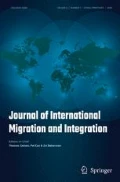Abstract
The experiences of racialized immigrant women in Canada bring into sharp focus constructions of home and sense of belonging. Embedded within their constructions of home is a sense of security. It is this sense of security that motivated many immigrants to choose Canada as home. However, the concept of home remains elusive, and belonging is highly contested. This article explores the experiences of racialized immigrant women who are living with the paradox of home without security and security without home.
Similar content being viewed by others
References
Agnew, J. (2002). Place and politics in modern Italy. Chicago, IL: University of Chicago Press.
Antonisch, M. (2010). Grounding theories of place and globalisation. Tijdschrift voor Economische en Sociale Geografie, 102(3), 331–345.
Augé, M. (1995). Non-places. Introduction to an anthropology of super modernity (pp. 75–115). London: Verso.
Bauman, Z. (2001). Community: Seeking safety in an insecure world. Malden, MA: Blackwell.
Berry, J. W. (2005). Acculturation: living successfully in two cultures. International Journal of Intercultural Relations, 29, 697–712.
Brah, A. (1996). Cartographies of diaspora: Contesting identities. London: Routledge.
Castagna, M., & Dei, G. J. S. (2000). An historical overview of the application of the race concept in social practice. In A. Calliste & G. J. S. Dei (Eds.), Anti-racist feminism: Critical race and gender studies (pp. 19–37). Halifax, NS: Fernwood.
Cervero, F. (2008). Pain theories. In A. I. Basbaum, A. Kaneko, G. M. Shepherd, & G. Westheimer (Eds.), The senses: A comprehensive reference (Pain, Vol. 5, pp. 5–10). San Diego: Academic Press.
Chavis, D. M., & Wandersman, A. (1990). Sense of community in the urban environment: a catalyst for participation and community development. American Journal of Community Psychology, 18(1), 55–81.
Chui, T. (2003). Longitudinal survey of immigrants to Canada: Process, progress and prospects. Ottawa: Statistics Canada. Catalogue No. 89-611-XIE.
Clark, R., Anderson, N. B., Clark, V. R., & Williams, D. R. (1999). Racism as a stressor for African Americans: a biopsychosocial model. American Psychologist, 54(10), 805–816.
Connell, J. P., Halpern-Felsher, B. L., Clifford, E., & Crichlow, W. (1995). Hanging in there: behavioral, psychological, and contextual factors affecting whether African-American adolescents stay in high school. Journal of Adolescent Research, 10(1), 41–63.
Edwards, S. (March 8, 2007). UN calls Canada racist for ‘visible minorities’ tag. CanWest News Service. Retrieved December 3, 2007 from http://www.canada.com/topics/news/national/story.html?id=f469b36e-c587-40e7-98e5-3aa50a371318&k=23802.
Essed, P. (2002). Everyday racism: A new approach to the study of racism. In P. Essed & D. T. Goldberg (Eds.), Race critical theories (pp. 176–194). Massachusetts: Blackwell Publishers Inc.
Fischler, R., Aubin, R., Kraemer, S. & Wiginton, L. (2013). Cooperative housing and the social integration of immigrant households. CMQ-IM no 52. Centre Métropolis du Québec.
Gupta, A., & Ferguson, J. (Eds.). (1999). Culture, power, place: Explorations in critical anthropology. London: Duke University Press.
Hogarth, K., Janzen, R., & Hatzipantelis, M. (2005). Qualification recognition and enhancement. A discussion paper for the immigrant skills summit Waterloo Region. Kitchener, ON: Centre for Research and Education in Human Services.
Ilcan, S. (2002). Longing in belonging: The cultural politics of settlement. Connecticut: Praeger Publishers.
Kaplan, W. (1993). Belonging: The meaning and future of Canadian citizenship. Montreal: McGill-Queen’s University Press.
Kumsa, M. K. (2005). Between home and exile: Dynamics of Negotiating Be-longing among young Oromos living in Toronto. In W. J. Tetty & K. P. Puplampu (Eds.), The African diaspora in Canada: Negotiating identity and belonging (pp. 175–204). Calgary, Alberta: University of Calgary Press.
Kunz, J. I. (2003). Social capital: A key dimension of immigrant integration. Canadian Issues, April, pp. 33–34.
Larson, A., Gillies, M., Howard, P. J., & Coffin, J. (2007). It’s enough to make you sick: the impact of the health of aboriginal Australians. Australian and New Zealand Journal of Public Health, 31(4), 322–329.
Marshall, T. H. (1950). Citizenship and social class and other essays. Cambridge: CUP.
Maslow, A. H. (1970). Motivation and personality (2nd ed.). New York: Harper & Row.
McMillan, D. W., & Chavis, D. M. (1986). Sense of community: a definition and theory. American Journal of Community Psychology, 14(1), 6–23.
Omi, M., & Winant, H. (1986). Racial formation in the United States: From the 1960s to the 1980s. New York: Routledge & Kegan Paul.
Pretty, G. M. H., Conroy, C., Dugay, J., Fowler, K., & Williams, D. (1996). Sense of community and its relevance to adolescents of all ages. Journal of Community Psychology, 24(4), 365–379.
Romero-Canyas, R., Downey, G., Reddy, K. S., Rodriguez, S., Cavanaugh, T. J., Pelayo, R., et al. (2010). Paying to belong: when does rejection trigger ingratiation? Journal of Personality and Social Psychology, 99(5), 802–823.
Statistics Canada. (2003). Ethnic diversity survey: Portrait of a multicultural society. http://www.statcan.gc.ca/pub/89-593-x/89-593-x2003001-eng.pdf. Accessed 8 June, 2010.
Tetty, W., & Puplampu, K. (2005). African diaspora in Canada. Calgary: University of Calgary Press.
Walton, G. M., & Cohen, G. L. (2007). A question of belonging: race, social fit, and achievement. Journal of Personality and Social Psychology, 92, 82–96.
Winchie, D. B., & Carment, D. W. (1989). Migration and motivation: the migrant’s perspective. International Migration Review, 23(1), 96–104.
Wong, Y.-L. I., Sands, R. G., & Solomon, P. L. (2010). Conceptualizing community: the experience of mental health consumers. Qualitative Health Research, 20(5), 654–667.
Yon, D. A. (2000). Urban portraits of youth: on the problem of knowing culture and identity in intercultural studies. Journal of Intercultural Studies, 21(2), 143–157.
Author information
Authors and Affiliations
Corresponding author
Rights and permissions
About this article
Cite this article
Hogarth, K. Home Without Security and Security Without Home. Int. Migration & Integration 16, 783–798 (2015). https://doi.org/10.1007/s12134-014-0367-z
Published:
Issue Date:
DOI: https://doi.org/10.1007/s12134-014-0367-z



